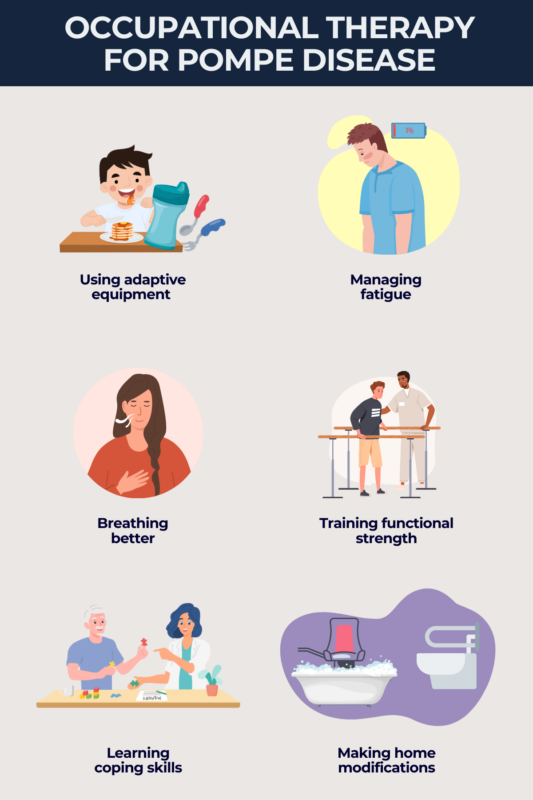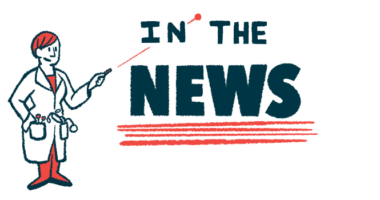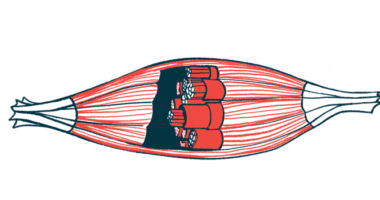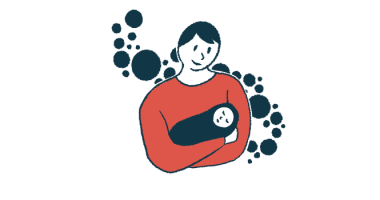Occupational therapy for Pompe disease
Last updated Aug. 9, 2024, by Susie Strachan

An occupational therapist can work with people who have Pompe disease on modifying how they do everyday tasks and routines to help conserve energy, reduce pain, and manage disease symptoms more effectively.
Pompe disease can affect your muscles, heart, and lungs, making it difficult to walk, breathe, and maintain good posture.
An occupational therapist can show you how to use assistive devices to make walking easier, work with you on breathing techniques to enhance your lung function, and recommend postural adjustments and supportive equipment to promote better body alignment.
By creating a personal care plan, an occupational therapist can help you navigate your daily life with greater ease and confidence. This support can help you live more independently and improve your quality of life.
What is occupational therapy?
Occupational therapy (OT) provides a number of strategies to help you take care of daily tasks, whether at home, school, or work.
This can mean working with you to maintain or improve daily living skills, such as dressing, eating, bathing, or grooming. They might also address your fine motor skills, hand-eye coordination, mobility, and physical functions, such as transferring from your bed to wheelchair or getting in and out of the shower.
An occupational therapist for Pompe disease may want to look at your home, school, or place of work and recommend modifications and accommodations.
Occupational therapy is different from physical therapy, but they are often complementary. While OT helps with figuring out the best way to do everyday tasks and activities, physical therapy uses exercises and stretching routines to maintain muscle strength and function.
Benefits of occupational therapy for Pompe disease
Pompe disease causes progressive muscle weakness as well as other symptoms such as chronic fatigue, breathing problems, and heart disease.
Occupational therapy for Pompe disease can help you develop strategies for day-to-day life as part of your Pompe disease treatment.
An occupational therapist assesses your ability to complete daily activities, checks your muscle strength and coordination, and then makes a plan that takes into account your goals and Pompe disease type.
For example, a young child with classic infantile-onset Pompe disease may need help reaching developmental milestones such as sitting, crawling, and walking.
An occupational therapist might use play-based activities to teach a child how to grasp toys, feed themselves, or hold a crayon while drawing. The therapist also may evaluate the child’s school environment and make suggestions for adaptive equipment and how to interact with other children.
An adult diagnosed with late-onset Pompe disease may want to focus on maintaining independence at home and at work. So an occupational therapist for Pompe disease who works with adults may make recommendations such as how to best organize a workspace to minimize unnecessary movements and assistive technology to accommodate physical limitations.
The therapist also can suggest home modifications to ensure safety and accessibility. It might involve installing grab bars, ramps, and stairlifts to make it easier for a person with Pompe to move around their home.
Occupational therapists also can work with caregivers, showing them how to assist with activities such as:
- transferring from bed to chair or from sitting to standing
- adjusting positions, such as while seated or sleeping, to relieve pressure points
- setting up respiratory equipment, such as a CPAP machine or cough assist device
- putting on and removing orthotic devices
- helping with gentle stretching and other home-based exercise.

Treatment strategies
An occupational therapist can show you how to use adaptive equipment, manage fatigue, and do breathing exercises and functional strength training, such as sit-to-stand exercises to strengthen your leg muscles, to improve Pompe disease management.
Adaptive equipment
An occupational therapist can figure out the best adaptive equipment for Pompe disease-related issues.
This might include aids such as:
- rollators, walkers, wheelchairs, and power scooters
- toilet safety frames, bathtub lifts, and shower transfer benches
- adjustable beds and leg lifters to move legs into bed
- adaptive clothing, sock aids, and button hooks
- adaptive utensils, cups, container openers, and plates
- voice amplifiers and speech generating devices
- systems that allow control of lights, temperature, and appliances.
Occupational therapists also may know about the emerging field of robotics, which can help people with Pompe with eating, grooming, and other daily tasks.
Robotics that are commonly used include:
- robotic arms that attach to a wheelchair or table to help with eating, drinking, and carrying objects
- assistive robots that can fetch and carry objects, turn lights on or off, and open doors.
Managing fatigue
Learning how to pace activities is an important part of dealing with Pompe-related fatigue. Occupational therapy for Pompe disease can help you figure out how to build in regular breaks to avoid overexertion and conserve your energy.
Managing fatigue might include:
- learning how to break tasks into smaller, manageable steps
- planning your day around high- and low-energy activities
- using ergonomic tools
- sitting while doing activities such as cooking or taking a shower.
Breathing exercises
As Pompe may weaken the muscles of your chest and diaphragm — which is a dome-shaped muscle below the lungs that helps you inhale and exhale — an occupational therapist can set up exercises to strengthen these muscles and increase your lung capacity.
Exercises might include:
- deep breathing, with an emphasis on using the diaphragm as opposed to just the chest
- pursed lip breathing, or inhaling through the nose and exhaling through the mouth with pursed lips, to help control shortness of breath
- coughing techniques that help clear secretions from the lungs.
Functional strength training
Occupational therapy for muscle weakness can help you strengthen muscles that are involved in everyday tasks. It is called functional strength training.
An occupational therapist can observe your daily routine, such as preparing food, carrying groceries, lifting objects, and moving around.
The therapist will then work with you on muscle strengthening exercises that mimic movements used in your daily activities.
These exercises might include:
- practicing sit-to-stand movements to strengthen lower body and core muscles
- learning proper techniques for lifting and carrying objects to avoid strain or injury
- reaching for items at different heights to increase coordination
- reaching for items overhead to improve range of motion
- climbing stairs to strengthen the legs and heart.
Collaborative care
Your occupational therapist will work with the people on your healthcare team to ensure you have coordinated care to better help you navigate the complexities of living with Pompe disease.
Your multidisciplinary team — which may include a neurologist, pulmonologist, and physical therapist — will communicate any changes in your Pompe symptoms to your occupational therapist so they can adjust your Pompe disease treatment plan as needed.
For example, occupational and physical therapists can work together on an exercise plan. Your occupational therapist might also consult respiratory therapists about recommended breathing exercises.
Your family and caregivers also can learn strategies and techniques from your occupational therapist. Caregivers can learn how to assist with daily tasks, such as safe transfer methods, proper positioning, and adaptive feeding.
Pompe Disease News is strictly a news and information website about the disease. It does not provide medical advice, diagnosis, or treatment. This content is not intended to be a substitute for professional medical advice, diagnosis, or treatment. Always seek the advice of your physician or other qualified health provider with any questions you may have regarding a medical condition. Never disregard professional medical advice or delay in seeking it because of something you have read on this website.
Related articles






